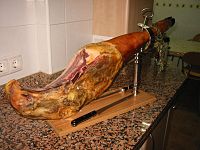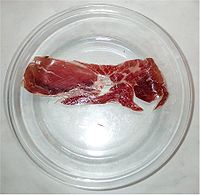- Denominación de Origen
-
See also: Protected designation of origin
Denominación de Origen (Designation of Origin - DO) is part of a regulatory classification system primarily for Spanish wines (similar to the French appellations) but also for other foodstuffs like honey, meats and condiments. In wines it parallels the hierarchical system of France (1935) and Italy (1963) although Rioja (1925) and Sherry (1933) preceded the full system. In foods it performs a similar role, namely regulation of quality and geographical origin among Spain's finest producers. There are five other designated categories solely for wine and a further three specifically covering food and condiments, all recognised by the European Union (EU). In Catalonia, two further categories - Q and A - cover traditional Catalonian artisan food produce, but were not recognised by the EU as of 2007.
Contents
Definition
The Spanish Ministry of Agriculture, Fisheries and Food (MAPA - Ministerio de Agricultura, Pesca y Alimentación) regulates the quality of Spanish foodstuffs via a labelling system which establishes, among other things, a Denominación de Origen for the country's highest quality produce. A semi-autonomous governing body (Consejo Regulador) exists for each region and for each food type, comprising skilled, impartial members who investigate the quality, ingredients and production process of each product, ensuring they attain specific quality levels. They report to a central council at national government level but are normally based in the largest population centre of a given region and are responsible for enforcing its geographical limits. Products labelled Denominación de Origen, apart from being of superior quality, are expected to carry specific characteristics of geographical region or individual producer and be derived from raw materials originating within the region. Like most of these designations, a fundamental tenet of a DO label is that no product outside of that region is permitted to bear the name.
History
Food and wine are inseparable from Spanish culture, historically bound to the social, economic, literary and even mystical fabric of society over thousands of years, so it is perhaps not surprising that attempts to regulate and normalize activities related to them have proven highly elusive. It wasn't until the 17th century, when legislative authorities became sufficiently interested in issues such as public health, public order and economic regulation, that laws begin to be formulated with regard to wine, initially prohibiting, later encouraging and ultimately regulating its production, commercialization and consumption. Food regulation waited even longer, until Spain's entry into the EU and signing up to the Common Agricultural Policy during the latter part of the 20th century.[1]
A series of Royal Decrees on wine were issued during the 18th and 19th centuries, focussing on ad hoc issues which arose due to new tendencies at home and abroad and often dealing more with maverick suppliers than any concern with comprehensive regulation. Gradually though, concern shifted from issues related to supply towards the need to regulate quality, especially for foreign markets. During the 1920s serious attempts were made to formulate some kind of classification along the lines of the French appellation system. Following the establishment of the Rioja as the first Spanish denominación in 1925, the Estatuto de Vino of 1932 coincided with national and international recognition of the sherry-producing region of Jerez.
Despite being thorough and wide-ranging, the Estatuto was quickly overwhelmed by technological advances in agriculture. By the time the EEC became influential in this area it was clear that the law would require fundamental re-drafting. A new Estatuto, the Ley del Vino y de los Alcoholes (25/1970) came into place in December 1970 but was again undermined, this time by two important events: the new Spanish Constitution (inaugurated in 1978) that restated geographical considerations with the Estado de las Autonomias, and Spain's pending membership of the European Community (1986) that brought about a rapid classification of all Spanish produce in line with other member states.
Finally, in March 1996, the Spanish government unveiled its own multi-tier sub-classifications, consistent with EU regulation but more pertinent to Spanish agriculture. Hence, for example, the EU's Quality Wines Produced in Specified Regions (QWPSR) covers all Spanish wines graded above the basic Vino de Mesa (table wine), within which the Spanish Denominación de Origen forms a subset.[2] This has coincided with a rise in the perceived quality of Spanish produce generally and has been widely acclaimed, although some areas, like the super-strict Denominación de Pago, remain controversial and liable to future amendment.[3]
Product types
Denominaciones de Origen status can be applied to a wide range of foods and condiments, specifically:
- Cider
- VCPRD wines
- Vinos de la Tierra
- Distilled alcoholic drinks
Quality foods may be designated a range of classifications, of which Denominación de Origen is the recognition of superior quality, with identifiable characteristics and specific ingredients, derived from an identifiable and verifiable source. Other classifications, not necessarily mutually exclusive, are as follows, under the general heading of Alimentos de Calidad Diferenciada (Foods of Differentiated Quality):
Denominación de Origen Protegida (DOP, or Protected Denomination of Origin) - An EU designation referring to food products specific to a particular region or town conveying a particular quality or characteristic of the designated area.
Indicación Geográfica Protegida (IGP, or Protected Geographical Indicator) - Similar to DOP but relating to a wider, less specific, geographical region.
Especialidades Tradicionales Garantizadas (ETG, or Traditional Specialty Guaranteed) - Products made using traditional ingredients, recipes or methods.
Artisan Food Product Stamp (A) - Recognizing small, family-run food businesses with high quality, distinctive produce overseen by a qualified artisan (Catalonia only, not recognized by the EU).
Food Quality Stamp (Q) - Foods with superior quality composition, production methods or presentation (Catalonia only, not recognized by the EU).
Producción Agricultura Ecológica (PAE, or Organic Agricultural Production) - A stamp guaranteeing natural, environmentally-friendly production methods.[4][5]By 2004 Spain had 250 Denominaciones de Origen and Indicaciones Geográficas Protegidas, over half of which related to food.[1] The following list of better-known Denominaciónes de Origen is by no means exhaustive:
 A leg of serrano ham on a jamonera
A leg of serrano ham on a jamonera
Olive oil
The Denominaciónes de Origen for olive oil include:
- Aceite Monterrubio - from Badajoz in Extremadura, mostly Cornezuelo and Picual varieties.
- Baena - Hojiblanca, Picual and Lechín varieties from the south-east of the province of Cordoba.
- Les Garrigues - Arbequina and Verdiell varieties from the province of Lleida in Catalunia.
- Priego de Córdoba - Picado, Hojiblanca and Picual varieties from the province of Córdoba.
- Sierra Magina - Picual variety from the southern part of Jaén province.
- Sierra Segura - mostly Picual from the north-east of Jaén province.
- Siurana - Arbequina, Royal, and Murrot varieties from the province of Tarragona.
Iberian ham (Jamón Iberico)
See also: JamónThe famous jamón serrano has several Denominaciónes de Origen, including:
- Huelva - source of the renowned (and expensive) Jamón de Jabugo.
- Teruel
- Guijuelo - well-known for Jamón y Paleta Ibéricos de Bellota (from Acorn-fed pigs)
- Dehesa de Extremadura
- Los Pedroches
Cheese
- Tetilla unusually-shaped cheese from Galicia.
- Cabrales - Asturian blue cheese.
- Picon Bejes-Tresviso - from Liébana region in the province of Cantabria.
- Liebana - from Cantabria, renowned for smoked cheeses.
- Cantabria - "fresh" Cantabrian cheese.
- Idiazábal - famous Basque cheese whose DO covers Alava, Biscay, Gipuzkoa, and Navarre.
- Roncal - from Navarre.
- Zamorano - from Zamora
- Manchego - the most famous and popular of Spanish cheeses is from La Mancha province.
- La Serena - sheep's milk cheese from Badajoz.
- Afuega'l pitu - cow's milk cheese from Asturias.
Vinegar
There are just three Appellations for vinegar in the EU, of which two are in Spain:
- Vinagre de Jerez - Sherry Vinegar from Jerez
- Condado de Huelva - White wine vinegar from Condado
Wine
See also: Spanish wine regionsWine region classification in Spain takes a quite complex hierarchical form in which the Denominación de Origen is a mainstream grading, equivalent to the French AOC and the Italian DOC. As of 2011, Spain has 120 identifiable wine regions under some form of geographical classification (10 DO de Pago/VP; 2 DOCa/DOQ; 65 DO; 4 VCPRD; and 38 VdlT. The Spanish DO is actually a subset of the EU-sponsored QWPSR (Quality Wine Produced in Specific Regions) regulatory code (Vino de Calidad Producido en Región Determinada (VCPRD) in Spanish) which Spain formally adopted in 1986, upon accession to the (then) EEC.[6] The Spanish appellation hierarchy for wines takes the following form up to 2009. From 2009 onward the new EU regulations apply - see below:
Denominación de Pago (DO Pago or VP - Vino de Pago) - Individual single-estates with an international reputation. From the 2009 vintage these will probably be known as VPP (Vino de Pago Protegida). This is as yet unconfirmed.
Denominación de Origen Calificada (DOCa/DOQ - Denominació d'Origen Qualificada in Catalan): quality wine regions with a track record of excellence. From 2009 these will be DOPCa/DOPQ - Denominación de Origen Protegida y Calificada/Qualificada.
Denominación de Origen (DO - Denominació d'Origen in Catalan) - mainstream quality-wine regions. From 2009 these will be DOP - Denominación de Origen Protegida.
Vino de Calidad Producido en Región Determinada (VCPRD) - less stringent regulation with specific geographical origin. After the 2009 vintage these will probably become DOP, but this is as yet unconfirmed.
Vinos de la Tierra (VdlT) - "country wine" areas which do not have EU QWPSR status but which may use a regional name. From 2009 these will become IGP - Indicación Geográfica Protegida.
Vino de Mesa - Table wine, production of which has been in decline in recent years. This is being replaced in part with Viñedos de España which, under the 2009 EU regulations, may state a vintage date and grape variety on the label.The 10 DO de Pago estates are:[7]
- Dehesa del Carrizal
- Dominio de Valdepusa
- Finca Élez
- Guijoso
- Señorío de Arínzano
- Prado de Irache
- Otazu
- Campo de la Guardia
- Pago Florentino
- Pago Casa del Blanco
The 2 DOCA/DOQ regions are:
The more prominent DO regions include:
- Jumilla (Murcia) is a very successful DO producing notable wines from ungrafted, pre-phylloxera Monastrell vines.
- Campo de Borja (Zaragoza) has recently become more prominent. It features a number of cooperatives who produce Garnacha and Tempranillo.
- Jerez-Xérès-Sherry
- Penedès (Barcelona) is notable not only for the production of the sparkling wine Cava, but popular red wines from Tempranillo, Garnacha and Carinena grapes.
- Rías Baixas (Galicia) is known for its Albarino varietals, Spain's number one white wine. Other whites grown here include Treixadura, Loureira, Caino Blanco, and Torrontes. Popular red grapes in this region include Caino Tinto and Souson.
- Ribera del Duero (Castilla y Leon) challenges Rioja for the best red wines produced in Spain. Almost all of its wines are made from the Tempranillo grape.
- Rueda (Castilla y Leon) located west of Ribera del Duero, producing notable reds and whites typically less expensive than those of its more famous neighbours.
- Priorat (Tarragona) and Rioja are the two highest-regarded wine producing regions in Spain and carry the special Denominación de Origen Calificada (DOCa)
- Toro (Castilla y Leon) located between provinces of Zamora and Valladolid, along de River Duero, producing notable reds, from Tinta de Toro, the local name for Tempranillo.
See also
References
- ^ a b http://www.mapa.es/es/alimentacion/pags/hechoscifras/espanol/pdf/18.pdf
- ^ [Denominaciones de Origen e Indicaciones Geográficas] - Alimentación - M.A.P.A
- ^ elmundovino.elmundo.es
- ^ Whole Foods Market : Recipes : European Designation of Origin for Wine and Food
- ^ [Alimentos de Calidad Diferenciada ] - Alimentación - M.A.P.A
- ^ [Denominaciones de Origen e Indicaciones Geográficas] - Alimentación - M.A.P.A
- ^ Langton, Patricia, Decanter.com (October 22, 2008). Navarra: new DO Pago
External links
- MAPA website (Spanish)
Categories:- Spanish cuisine
- Spanish wine
- Appellations
- Wine classification
Wikimedia Foundation. 2010.





